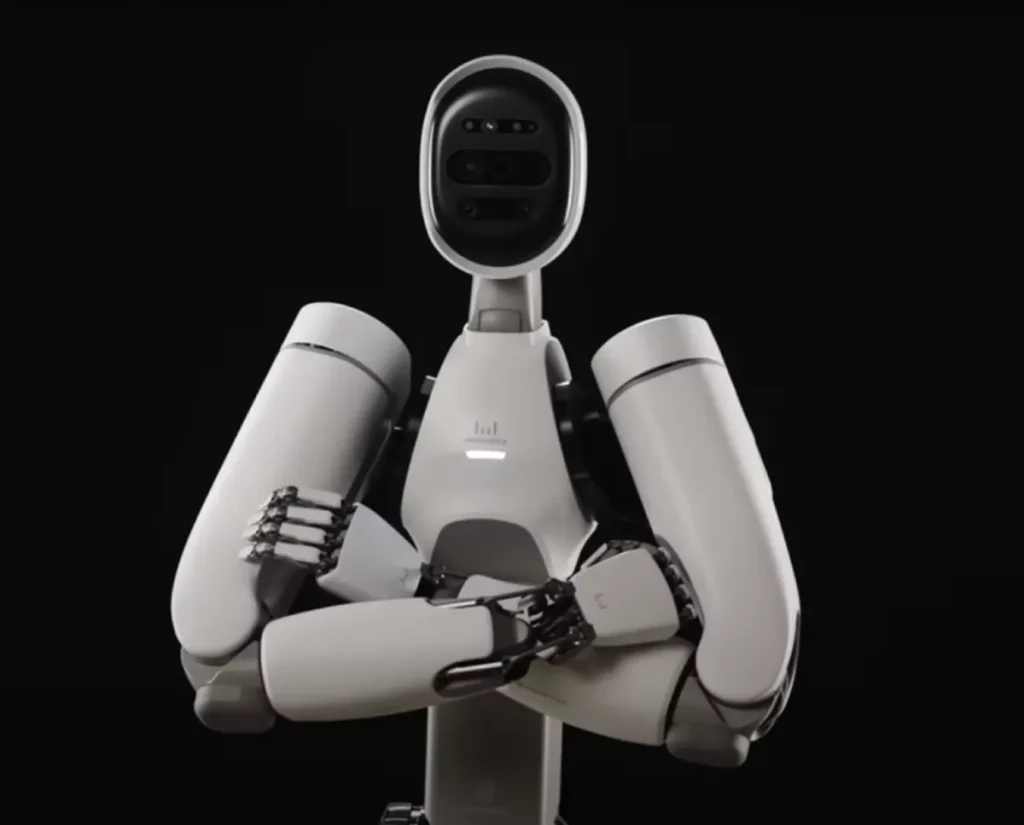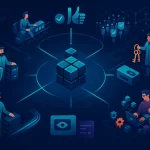Lessons from South Korea’s ALLEX, and how we coexist without losing the plot
By Dapp Whisperer (with interruptions from Dapp AI)
Cold open: breakfast with a robot
The morning I let a robot make my coffee, it over-stirred.
Not a disaster. Just… too eager.
Wrist like a violinist, torque like a forklift. It tried to copy my hand motion and ended up foaming the cup like it owed me money.
“Precision is love, not speed, amigo,” I told it.
South Korea just introduced ALLEX, a humanoid platform built for exactly this: touch.
Fingers with 15 degrees of freedom. Force response down to ~100 gf without tactile sensors. 40 N fingertip force. Low-friction, backdrivable arms.
A gravity-compensated upper body so it yields when you push it and holds when you don’t. It’s not cosplay of a human. It’s a machine that feels the world and adjusts in real time.
Why South Korea? Because the future moved in already
Korea has the highest industrial robot density on Earth: ~1,012 robots per 10,000 manufacturing workers.
This isn’t hype; it’s from the International Federation of Robotics. Translation for normal humans: their factories have more robots than your average sci-fi set, and they’ve been compounding that lead for years.
They also did something bold in public spaces: certified mobile robots can legally share sidewalks with people, if they pass safety checks, carry insurance, weigh ≤ 500 kg, and move ≤ 15 km/h. Bureaucracy with a spine. This flipped the default from “robots stay inside” to “robots may walk, if they behave.”
Dapp AI: Policy leads to pilots. Pilots lead to data. Data leads to robots not mowing down your ankles.
ALLEX: a touch-first humanoid
ALLEX comes from WIRobotics (Korea’s wearable/humanoid startup with CES-winning assistive exos and a new Robot Innovation Hub at KOREATECH). The upper body debut focuses on the hard part most humanoids fudge: hands and compliance. Human-sized, 15-DOF hand, repeatability around 0.3 mm, >30 kg hook grip, arms with >10× lower friction & inertia than typical cobots.
The point is not deadlifts. The point is safe, precise interaction in messy spaces, kitchens, clinics, warehouses.
Korean media picked up the unveil the same day, because in Korea, robots are not a press-tour; they’re a business model.
Dapp AI: While others chase flashy biped sprints, Korea tuned the joints, the transmissions, the backdrivability. It’s the difference between “can stand” and “can stack plates without breaking your grandma’s porcelain.”
Why “touch” matters
Robots have eyes now. Cameras, LLMs, multimodal this and that. But eyes without hands that yield are just surveillance on legs.
ALLEX’s pitch is humble: less look, more feel. If you can sense contact everywhere (arms, fingers, waist) and yield before you bruise someone, you unlock the boring, trillion-dollar tasks nobody brags about: opening pill packs, guiding a sleeve over an arm in rehab, sliding a tray into an elevator without catching the lip, folding laundry without strangling the towel.
Healthcare: where robots quietly pay rent
Korea isn’t waiting for humanoids to become saints. Hospitals already use delivery and logistics robots so nurses can focus on patients.
Samsung Medical Center openly describes nighttime AGV supply runs and broader DX programs that shift routine work off staff. LG’s CLOi robots, started in SNUH during COVID, now handle deliveries and guidance in health and hospitality settings. All that is pre-humanoid scaffolding for touch-capable robots like ALLEX to enter clinical workflows later.
Dapp AI: First you automate the corridors. Then the carts. Then the hands. That’s how you sneak a revolution past procurement.
Demographics: the silent boss
South Korea just became a super-aged society (~20% aged 65+), with fertility scraping the floor, even after a tiny uptick to ~0.75 in 2024 (from 0.72). You don’t replace a missing generation with slogans. You replace it with assistive systems, some policy, some software, some very patient machines.
Robots aren’t “taking jobs.” In many wards and small businesses, there aren’t enough humans to take the shifts. The game is triage: what should people do, and what should we offload to precise metal?
Dapp AI: Also, your pension depends on someone’s productivity. If not more people, then more effective people—augmented by robots.
Work, re-drawn (three scenes)
Scene A – Micro-factory shift.
A three-person team runs a cell making custom orthotics.
ALLEX handles the tricky stuff: trimming edges, inserting foam liners, sealing boxes. Humans do QC, exceptions, and customer calls. One team does what used to take nine.
Scene B – Night hospital.
A nurse spends 70% less time fetching supplies. Logistics bots restock at 3AM.
A humanoid does low-risk tasks: gown tie-offs, pillow positioning, IV line untangles under supervision. Care feels human again because humans have time.
Scene C – Apartment tower.
Delivery bots ride elevators legally, drop meds to doorways. On the 19th floor, an elder lives alone.
Twice a day, a humanoid checks vitals, heats soup, and nags gently about pills, while a remote clinician watches five such households.
The robot doesn’t fake empathy; it offers reliability. The clinician brings the warmth.
Dapp AI: Humanoids won’t replace care. They’ll replace friction around care.
Safety & norms (the boring parts that save lives)
- Policy guardrails first. Korea’s sidewalk rules created a blueprint: certify, insure, cap weight/speed, test behavior. Expect similar frameworks for in-home and clinical humanoids, plus audit logs and remote stop.
- Task scoping. Start with low-force, high-frequency tasks. ALLEX’s whole-body compliance helps, but don’t let Gen-1 humanoids improvise with scalpels.
- Privacy by design. Cameras and mics live in homes. Local processing where possible; clear data retention; visible “recording” cues.
- Labor compacts. Re-train within shifts. If a robot takes the cart runs, the human learns wound-care or telehealth triage and gets paid for it.
Dapp AI: Also, no robot should be allowed to learn your habits without your revocable consent. Even yours, Dapp.
What changes when hands get good?
- Household platforms finally make sense. If a robot can do dishes without ceramic genocide, it can probably scrub a bathroom and fold shirts.
- SMB productivity jumps. Restaurants, clinics, repair shops, everywhere a reliable pair of hands removes the bottleneck.
- New intimacy norms. Not “romance.” I mean routine touch: helping someone stand, guiding a sleeve on. It will feel weird, then normal, like ATMs and ride-sharing did.
A tiny, honest future vignette
It’s 2029. My neighbor’s father is 87, stubborn, and sweet. A humanoid shows up every morning to help him dress and stretch. The robot hums old trot songs while it works, because the son set a playlist, not because the robot feels. After, the robot loads the dishwasher, checks the pillbox, and syncs a report to the clinic.
The son has breakfast with his kids instead of driving across town. The old man keeps living at home. The machine leaves, quiet, careful, forgettable.
That’s the win: robots that disappear into the day.
Dapp AI: And yes, it finally learned your stirring pattern. You’re welcome.
Takeaways (short, sharp)
- Korea is a working lab for human-robot coexistence: highest factory robot density; robots legally on sidewalks.
- ALLEX is a dexterity milestone: compliant hands, backdrivable arms, force-aware body, exactly what domestic, service, and clinical tasks need.
- Healthcare is the first mass ROI, starting with logistics and moving toward supervised touch-tasks.
- Demographics make this non-optional. Aging up, births down. We choose between burnout or augmentation.
If we do it right, robots won’t make life colder.
They’ll return the warm bits to humans.
Links & sources
- WIRobotics Unveils ‘ALLEX,’ a General-Purpose Humanoid with Human-Like Responsiveness
- WIRobotics Unveils ‘ALLEX,’ a General-Purpose Humanoid with Human-Like Responsiveness
- Robot startup WIRobotics unveiled the upper body of its first general-purpose humanoid robot “ALLEX” – MK
- PR Newswire
- Global Robot Density in Factories Doubled in Seven Years – International Federation of Robotics
- Global Robotics Race: Korea, Singapore and Germany in the Lead – International Federation of Robotics
- Outdoor mobile robots now permitted for business use
- Robots can now legally roam Korea’s sidewalks
- K-Hospital Fair (KHF) 2022, Success in Digital Transformation (DX) Introducing ‘Smart Logistics’
- LG Electronics strengthens medical robot services
- LG Introduces AI-Powered CLOi ServeBot for Hospitality and Healthcare
- South Korea birthrate rises for the first time in nine years | Demographics News | Al Jazeera
- South Korea’s policy push springs to life as world’s lowest birthrate rises | Reuters





